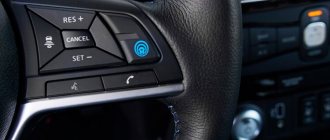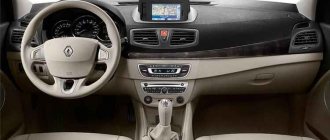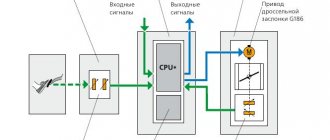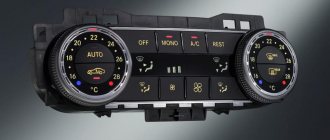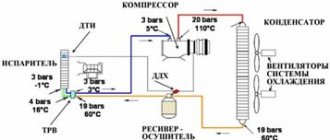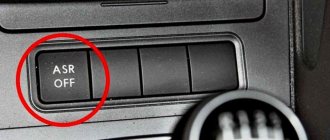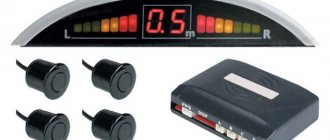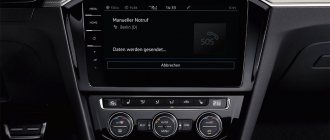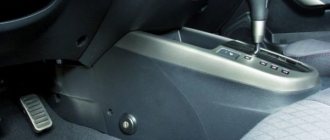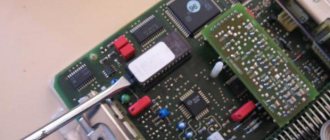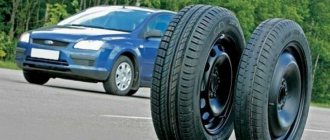Buyers of foreign cars are mainly interested in cruise control, since this option is more typical for cars of foreign manufacturers than for our domestic ones.
When future buyers see “cruise control +” in the description and technical characteristics of the car they are interested in, most of them, especially women, have a question: what is it and is it worth paying for this option.
Therefore, it would be useful for many future car owners to understand what meaning the word cruise control carries, what types there are, how to use it in practice, and whether it is worth paying attention to this option in the car at all.
We give a definition
Cruise control is a system thanks to which, when driving long distances on highways, the car can move at a constant speed set by the driver.
At the stage of its operation, the system independently decides on which section of the road it is worth reducing the fuel supply, for example, on a descent, and on which section of the road, on the contrary, it is worth increasing the fuel supply, for example, on an ascent.
The driver's participation during operation of this system consists only of turning the steering wheel in the desired direction, and the cruise control does the rest.
But this system is more effective when driving on intercity and international highways; when driving around the city it is not turned on, here it is practically useless.
Precautionary measures
No matter how advanced the electronic device of your car is, remember, cruise control is prohibited from being used when:
- when the road surface is icy;
- when driving on a wet road;
- in case of insufficient visibility (at night, during rain, snowfall, fog).
In the described cases, car manufacturers recommend that drivers take control of the vehicle.
Cruise control has truly made life easier for truckers and road travelers during tedious journeys on smooth and straight roads.
And yet such control cannot be called “unmanned”; be careful! Ask a Question
A little history
The first car to have cruise control was called the Chrysler Imperia. The system was passive and worked on the principle of automatically regulating the fuel supply to the combustion chamber.
This happened back in 1958; for those times it was a breakthrough.
Despite the fact that technology was advancing very quickly in those days, and even now, adaptive cruise control only appeared in the late 90s. They were equipped with Mercedes cars.
And, although now the number of types of data systems has not changed (passive and adaptive), their operating principles have changed a lot and are constantly changing.
Future Application of ACC
A few years ago, Google launched its self-driving car, which relies entirely on autonomous cruise control technology.
Google's self-driving car
This car has a total of eight sensors. Most notable is the Rotating Roof Lidar, a camera that uses an array of 32 or 64 lasers to measure the distance to objects to create a 3D map up to 200m away, allowing the car to analyze potential hazards.
Additional features and security
In most cars, the cruise control system has additional features that, on the one hand, are convenient and, on the other hand, increase driving safety.
For example, cruise control is automatically turned off if the driver presses the brake pedal at least once. After this, you will have to turn on the system manually again by clicking Resume, and the previous speed will be restored.
On some cars, cruise control turns off when the driver overtakes or temporarily increases speed by pressing the gas pedal, and automatically turns on when the gas pedal is released.
When the vehicle speed decreases to 40 km/h or less, as a rule, the system is switched off.
Also, if the driver has a desire to increase or decrease the cruising speed of the car, then he needs to operate certain buttons.
After pressing one of the buttons once, the speed will increase by 2 km/h, twice by 4 km/h, three times by 6 km/h, i.e. the speed increase step is 2 km/h.
The same thing happens with decreasing speed, only in the opposite direction and you need to press another button.
How to find out if it is in the car
Many buyers are interested in this option, and they are willing to overpay money for it. To do this, you need to figure out how to find out if your car has cruise control. The work can be done in two ways:
- Look into the interior and look for the presence of buttons on the steering wheel / steering column switch. If they are provided, the system is most likely included in the machine. The only question that remains is whether it works or not.
- View technical specifications. The vehicle parameters for a specific configuration indicate whether the system is provided. Additionally, the operating instructions should contain information about how cruise control is useful, how to use it, and how to turn it on and off.
If the system does not work for some reason, computer diagnostics may be required. In addition, it is often necessary to check the integrity of the fuse, the tightness of the tube from the vacuum reservoir to the brake pedal, the integrity of the wires, the serviceability of the vacuum pump, the integrity of the wires, etc.
Cruise control control
To use this function correctly, you need to learn how to manage it.
Depending on the make of the car and the type of cruise control installed on it, the number of control buttons and their installation location may differ.
As a rule, there are 5 buttons and they are all located on the steering wheel. But there may be differences, for example, the Nissan X-Trail has 4 control buttons.
Let's consider the classic version with 5 buttons.
Below is a classic layout of cruise control control buttons.
On the left of the steering wheel there are two On and Off buttons, and on the right are the remaining control buttons.
Set/Accel - by pressing this button, the driver will record the speed at which he is currently driving. Pressing it a second time will increase the speed by 2 km/h, again and another 2 km/h, etc.
Coast – after pressing this button and holding it in the on position, the vehicle speed will gradually decrease until the button is released.
Resume button - it is pressed to restore cruising speed after being forced to press the brake pedal.
Below are other options for the location of cruise control control buttons and their number.
CANCEL – after pressing this button, the previously set cruising speed is canceled; it is not provided for all cars.
Fine for driving a car or other vehicle without a license
- Laser adapters are more accessible and their price is lower. But this is due to the fact that in bad weather the laser simply does not see obstacles. If a dirty car is moving ahead, CC simply won’t see it;
- Radar systems are installed on expensive cars. They see much better and are therefore the preferred choice. But the price is higher.
The latest developments in adaptive cruise provide signals to the driver. And some models even independently decide instead of the driver to brake urgently if necessary.
But I’ll add something of my own. Even such advanced electronics should not be completely relied upon. The world is not yet ready for autopilots and other systems. Yes, cruise control often simplifies driving and makes traveling by car more comfortable.
However, trust only your own driving experience if the weather is bad, foggy, raining or snowing, or the road is covered with ice. In such situations, it is strictly not recommended to turn on the cruise.
Thanks for reading. Hope you enjoyed it. Write your opinion in the comments, subscribe and invite your friends to join us!
Types of cruise controls
Modern cruise controls are divided into two types:
- Passive;
- Adaptive.
Adaptive cruise control, in turn, is divided into:
- Radar;
- Laser.
Passive CC.
About everything that was written above, this is passive cruise control. Its function is to maintain the desired speed throughout the journey until unusual situations arise that force the driver to press the brake or gas pedal.
Also read - TPMS tire pressure and temperature monitoring system, device, principle of operation, main market players, Whistler ts-104 and Autofun TPMS-201a.
Adaptive.
Adaptive cruise control is more functional than passive cruise control. The highlight of its work is that, in addition to having functions from a passive device, it allows you to control the distance to driving or standing objects in front and warn the driver of danger, and in a critical situation, automatically brake the car.
The main task is to prevent a collision with a moving or standing object ahead.
But you need to understand that the operation of this system directly depends on the work:
- ABS brake system;
- ESP safety systems.
Therefore, adaptive cruise control stops working if at least one of the above systems does not work, which warns the driver with a signal.
This is its main drawback.
If we consider laser or radar adaptive cruise controls, then the latter are considered more effective, since laser ones do not work well in rainy and snowy weather.
Radar cruise controls are effective in any weather, but greatly affect the price of the car, which is why such devices are mainly included in luxury cars.
The practice of using adaptive devices has shown that not all drivers trust them, and for good reason.
There have been cases when the distance to the car in front was indicated incorrectly due to bad weather, or the device signaled about a car that was actually not ahead.
Therefore, technology is technology, but the driver still must be alert.
What is adaptive cruise
Adaptive Cruise Control (ACC) is an advanced cruise system that allows you to independently change the speed of your vehicle depending on the road situation. For example, a car can brake on its own if a potential collision danger is detected ahead.
AAS consists of three main components:
- touch sensors that determine the distance and interval between your car and other road users. Range of action from 30 to 200 meters. The emitter can be infrared, electromagnetic or ultrasonic;
- a control unit that collects information from sensors takes into account the distance to the previous vehicle, the speed of your car, and then regulates the process of accelerating or braking;
- a set of equipment connecting the transmission, safety sensors (ABS+EBD), and brake mechanisms.
Control system
The control systems for passive and adaptive cruise controls have some differences.
In both cases, it is controlled by a small computer that receives data from special sensors. The computer has a connection to the throttle, which it controls.
However, with adaptive devices, the computer still has contact with the ABS and ESP safety systems and works synchronously with them.
Is it possible to install it yourself?
The procedure for installing cruise control is quite complex and will require certain skills and special equipment. It must also be said that the system is not installed on all cars.
You will need equipment to flash the engine control unit, and for this you will need the help of programmers who know what cruise control is in a car. You will also need to redo the brake system, replace ABS units and flash the automatic transmission.
There may be problems with the operation of the system. It doesn't always load and work as intended the first time. It happens that there are no errors in the work, but the system does not want to act. Some car models (in particular VAG) may require the installation of a second engine control unit.
Radars and lidars
The cruise control has a distance sensor. This element is necessary to be able to measure the parameters of speed and distance to the vehicle in front. Radars or lidars are used as such sensors. These sensors emit electromagnetic waves or infrared rays. The system estimates the speed of a moving car by how the frequency of the reflected electromagnetic wave changes. And the distance is calculated by how long the signal took to return.
Lidars, unlike radars, do not send electromagnetic waves, but special infrared laser beams, but the principle of their operation is more or less the same. But the sensors for these systems are much cheaper than radars. However, the product is exposed to the elements, so you won't find leaders in today's premium machines. Only radars are installed here.
Distance sensors are installed on the front bumper and radiator grill of the car. The sensor works normally within a radius of up to 150 m.
The latest versions of cruisers use rangefinder devices that operate at both short and long ranges. The first one can change the speed limit until the car comes to a complete stop. The second, operating in a far radius, reduces the vehicle speed to 30 kilometers per hour. This allows you to expand the capabilities of the assistant (for example, use a cruiser in a traffic jam where low speed is needed).
